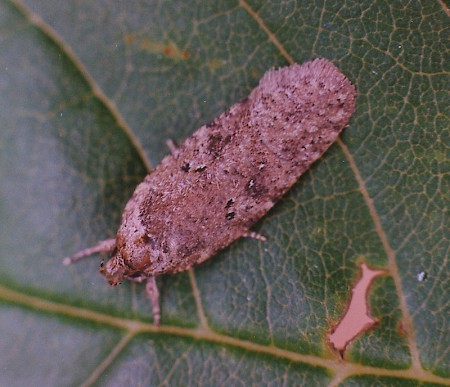32.018 BF688
Agonopterix heracliana
(Linnaeus, 1758)
Wingspan 21 mm. A common species throughout most of Britain, this moth can be found on the wing any time from September through to April.
The larvae spin the leaves of a variety of umbelliferous plants, occurring between May and July.
The species is a regular visitor to the light-trap in certain areas.
- Larva: (description Ian F. Smith):
Foodplants: Heracleum sphondylium, Anthriscus sylvestris, Chaerophyllum temulum, and most other Umbelliferae including Angelica sylvestris, Aegopodium podagraria, Conopodium majus, Daucus, Meum, Myrrhis, Oenanthe, Pastinaca, Silaum, Sison, Smyrnium, Torilis and Ligusticum.
Intermediate instar
Length: 12 mm & 13 mm described.
Head: Burnt ochre, with greenish cast of varying intensity, strongest on anterior. Posterior edge of epicranial spheres thinly edged black. Black postero-lateral spot. Mouthparts reddish brown. Stemmata connected by a blackish 'C' shaped band, enclosing a greyish stemmatal area.
Prothoracic shield: Transparent tinted amber. When viewed from above, appearing green when head extended and ochreous when head withdrawn. About three black pinacula laterally and a black dorso-lateral pinaculum towards the posterior.
Thoracic legs: Paler than body with light brownish tint. Coxa concolorous with venter.
Body: Light apple green. Yellowish intersegmentally. Dark green dorsal and dorso-lateral line on segments T2 to A8, faint or absent from A9 and A10.
Spiracles: Black peritreme.
Pinacula: Black.
Setae: Translucent tinted brownish.
Anal plate: Concolorous with body, sometimes with a very slight amber cast on the cuticle.
Prolegs: Concolorous with venter. Planta paler, translucent. Crochets light brown.
Late instar
Length: 15 mm described.
Head: Burnt ochre, with greenish cast of varying intensity, strongest on anterior. Posterior edge of epicranial spheres thinly edged black. Black postero-lateral spot. Mouthparts reddish brown. Stemmata connected by a blackish 'C' shaped band, enclosing a greyish stemmatal area.
Prothoracic shield: Transparent tinted amber. When viewed from above, appearing green when head extended and ochreous when head withdrawn. About three black pinacula laterally often joined by a thin crescentic black mark. Often, a prominent black dorso-lateral pinaculum towards the posterior.
Thoracic legs: Paler than body with light brownish tint. Coxa concolorous with venter.
Body: Apple green or moss green. Yellowish intersegmentally. Dark green dorsal and dorso-lateral line on segments T2 to A8, faint or absent from A9 and A10.
Spiracles: Black peritreme.
Pinacula: Black.
Setae: Translucent tinted brownish.
Anal plate: Concolorous with body.
Prolegs: Concolorous with venter. Planta paler, translucent, tinted light brown. Crochets light brown.
Similar species:
On Daucus, Conopodium and Meum the larva of Depressaria pullcherrimella can be distinguished by the lack of a black 'C' band connecting the stemmata, and by the stemmatal area being concolorous with the rest of the head.

 UKMoths
UKMoths 







